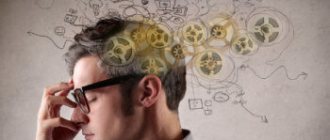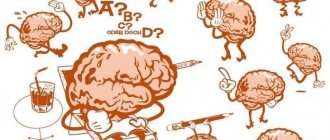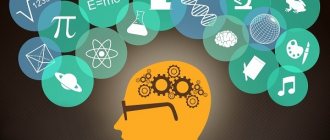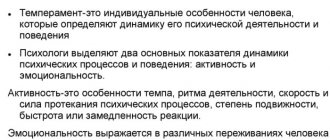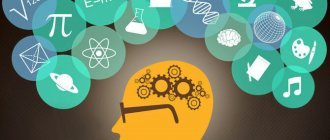Visual memory reflects a person’s ability to perceive and store information about an object in the external world obtained through the organs of vision. This type of memory presupposes people's ability to imagine and is especially important for representatives of certain professions - artists, engineers, designers. Visual memory training helps develop the skill.
Definition and types
Memory is a cognitive process as part of higher mental functions, the ability of a person to store in consciousness and mentally reproduce images, impressions, experiences, and events. There are types of memory (classification according to sensory modality - categories of perception and sensation) - visual, motor, auditory, gustatory, olfactory.
Modality influences the mechanisms of memory formation. Depending on the duration of data storage, a distinction is made between short-term and long-term. Visual is a memory that presupposes the presence of a semantic and episodic form, which allows us to differentiate the mechanisms of formation, use and associated neurophysiological processes.
The semantic part is a repository of objects of the external world and their meaningful meanings. The episodic part is closely connected with consciousness, contains images and events, and can be short-term or long-term. Retention of the image in consciousness correlates with its transformation, which is expressed in actions:
- Simplification, omission, exclusion of details.
- Exaggeration, strengthening of individual details.
- Transforming a visual pattern into a symmetrical, uniform figure.
The shape of the memorized object is more often rounded or expanded, the color changes towards common, frequently occurring shades. Unexpected, rare images are remembered more clearly, sharply and vividly. During the transformation that occurred during the memorization period, the non-standard, original visual pattern becomes more average, typical. Visual memory is difficult to control voluntarily, meaningfully, so many people wonder how to develop it.
Good visual memory usually occurs in childhood and adolescence. Adults have better developed logical memory. To train visual memory, you need to mentally reproduce given images, imagining the smallest details of the picture, such as shades of color, shape, position of objects in space.
By duration:
Short-term. A small amount of information is quickly remembered and just as quickly disappeared. The data is stored for up to approximately 30 seconds and without repetition can disappear forever.
Long-term. Information can be stored for quite a long time: from several hours to several years. But banal cramming without quality study of the material does not help here. Long-term memory requires conscious detailed learning, mental interpretation, and association with existing knowledge.
Operational. Memory is stored for a certain period of time while processes or actions are performed. It differs from short-term in that it regulates certain activities and is used to maintain its intermediate results.
Mechanisms of formation
In neurophysiology, memory is considered as a property of the central nervous system, which consists in storing information about events occurring in the environment, the body's reactions to them, and the ability to repeatedly reproduce and correct mentally imprinted information. The development of visual memory is impossible without the use of a technique such as repetition, which enhances memorization.
The psychophysical and neurophysiological mechanisms of the memorization process are based on the perception of an object in the external world as a set of specific features encoded into a single, integral image. The sensitivity of the system that recognizes objects stored in memory varies from person to person. Extraction of the desired object from the depths of memory is carried out using stimuli that are perceived by neurons in the associative areas of the brain.
Researchers have discovered that visual memory stores information about a large number of objects and partly about their properties. As part of the test task, subjects, after viewing a catalog of 10 thousand photographs, in 83% of cases choose a previously seen photograph from two alternative options (one is present in the catalog, the other is not). Moreover, the time allotted for the initial viewing of the catalog is several seconds.
Another experiment involved subjects being shown a catalog of 2.5 thousand photographs, divided into categories, for a certain period of time. Initially, the subjects were tasked with remembering more detailed information about the presented objects. The test task involved the presentation of a previously shown stimulus in 3 options: paired with an object from a different category, paired with an object from the same category, the same objects in a different position or in a different state.
The subjects correctly identified the stimuli presented during initial and repeat viewing in 92%, 88%, and 87% of cases, respectively. The experiment confirms a person's ability to remember specific characteristics of an object.
The mechanism of memory is built on automatic and conscious thought processes. In the first case, a person subconsciously experiences the feeling that the object is familiar to him, in the second, he purposefully tries to extract information from memory.
Instrumental diagnostics (EEG, electroencephalogram) of visual memory function showed negative wave activity in the frontal region of the brain when a feeling of familiarity arises in relation to an object. When trying to purposefully remember, positive waves arise in the parietal and central areas of the brain. Testing visual memory in patients with brain damage in the temporal lobe showed difficulties in recognizing visual images.
With damage to the frontal lobe, subjects retained the ability to recognize visual patterns, but had difficulty performing tasks related to spatial memory. To exclude pathologies that affect the deterioration of perception and memory of visual images, it is recommended to undergo examination by specialist doctors: an ophthalmologist, a neurologist.
Roman room method
This method, also called the Cicero chain, is a very effective way to teach how to structure information for better memorization. The bottom line is this: the objects to be remembered must be mentally placed in a well-known room (for example, in your room), but in a strictly defined order. And then later, in order to reproduce the necessary information, you will need to remember this room.
Allegedly, this is exactly what Cicero, a famous Roman thinker and orator, did before his speech. As he walked through his home, he placed the most important points of his speech in familiar or favorite corners. And while giving a speech, it was as if I was walking along this route again, remembering the key moments. You can, of course, use not only a room or a house as such a “storage,” but also the street, a closet, or even your desk, as long as these objects are well known for remembering these very “nooks and crannies.”
Testing your memorization efficiency
To check how effective the process of memorizing visual patterns is, you can take a test task. To do this, you need to take 10 images that you have not seen before. View them one by one for a minute. Then remove and list all the pictures from memory. The order is not critical. It is important to remember as many pictures as possible. The result of 8-9 images is considered excellent, 4-7 images – satisfactory, less than 3 images – unsatisfactory.
How to improve visual memory without wasting additional time?
Few people like to do exercises to train their memory, but you can improve it without spending extra time. There are several recommendations that, if followed, can significantly improve visual memory.
- Memories. To develop visual memory, you need to reproduce the events of the past day in as much detail as possible every day before going to bed, placing special emphasis on images and small details. By doing this exercise every day, you will quickly notice that the number of details that you can capture increases in number.
- You can constantly train your memory, especially if your profession involves contact with people. To develop visual memory, you need to try to reproduce in your head the details of the image of a person with whom you just communicated or even whom you simply passed by.
- Instant. Throughout the day, you can stimulate your visual memory by stopping unexpectedly or simply looking at an object, such as a painting. After looking at it for a couple of moments, you need to close your eyes and try to reproduce in your thoughts as accurately as possible everything that you managed to remember.
- Verbal portrait. This exercise is also helpful for people who have problems with visual memory. When getting to know a person, you should mentally describe the main details of appearance and behavior verbally. At the same time, you need to try to pay attention to many even small details. After which, after some time, you need to try to reproduce the verbal portrait in the form of an image.
Such simple exercises will help achieve stunning results in the development of visual memory. In addition, attentiveness and concentration will improve, and therefore, overall intellectual capabilities will increase.
Features in children
When a baby comes into this world, numerous cognitive techniques are not yet available to him, so vision is the first ability that allows him to recognize what is around him. As the child develops, other forms of cognition are added, but it is vision that stimulates the formation of ideas about the world around us.
WE RECOMMEND SEEING: How to help a child if he has a bad memory
Children have eidetic memory, of course, to varying degrees. This is of great importance in learning, since the ability to “grab everything on the fly” ensures quick memorization and improves the child’s knowledge.
Which of the greats had eidetic memory?
Many great people have had the gift of eidetic memory. This helped them keep in mind, combine and analyze a huge variety of different information in the areas of activity in which they were engaged. This quality was extremely useful in an era when personal computers did not yet exist. Here are just a few of these people:
Sergei Rachmaninov, Russian composer and pianist. Having once looked at unfamiliar notes, he could immediately play any complex musical composition with absolute precision.
Nikola Tesla, electrical physicist. I never used notes because I kept everything in my memory.
John Paul II, Pope. Fluent in 21 languages.
Seneca, Roman philosopher. In exact sequence, he recalled from memory two thousand words he read, often not even related in meaning.
Winston Churchill, British politician. Knew all of Shakespeare by heart.
Heinrich Schliemann, archaeologist. I studied any foreign language in a month and a half.
Paul Morphy, chess player. He remembered all the moves of the games he played.
Daniel Tammet. Able to name more than 22 thousand decimal π
Alexander Suvorov, Russian commander. He knew by sight and name every soldier in his army, which consisted of 24 thousand people.
Diagnostics
An adult can also pass the test for excellent visual memory if he so desires. But diagnostics in younger schoolchildren and preschoolers reveals disturbances in the processes of perception and assimilation of information.
Preschool-aged children undergo these tests to determine how ready they are for school or to evaluate their progress. Junior schoolchildren are tested to determine their mastery of the information presented in the primary grades. A well-developed memory allows a child to learn better and absorb knowledge much more effectively.
Who has more developed
It is believed that girls have better visual memory than boys. But there are other factors that provide the best conditions for the development of abilities. To generalize, we can say that those people who constantly use it have a greater volume and quality of memory.
For example, residents of the Far North live in very harsh conditions and are surrounded on all sides by a monotonous, monotonous landscape. But their visual perception often saves them in critical situations, instantly noting the slightest deviations from the usual picture. For example, a shadow flashing in the distance may mean that there is a bear or a hungry wolf pack nearby, and a change in the color of the ice will tell you that you should not step on it - a crack will form there and there is a risk of falling into the icy water.
The same goes for people who constantly deal with various visual information. For example, a scientist will instantly recognize a formula familiar to him, and a car mechanic will “calculate” the cause of a breakdown based on the external state of the engine, because he has already seen such a picture more than once.




